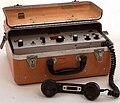Biophone
Biophone is a term used in the field of medicine and healthcare to describe a device that is capable of transmitting physiological data over a distance. The term is derived from the Greek words 'bios' meaning life and 'phone' meaning voice. Biophones are often used in telemedicine and remote patient monitoring to provide healthcare professionals with real-time information about a patient's health status.
History[edit]
The concept of the biophone dates back to the early 20th century, when inventors began experimenting with ways to transmit physiological data over a distance. The first biophones were rudimentary devices that could only transmit basic information such as heart rate and blood pressure. However, with the advent of digital technology in the late 20th century, biophones became more sophisticated and capable of transmitting a wider range of physiological data.
Function[edit]
A biophone typically consists of a sensor that is attached to the patient's body to monitor specific physiological parameters. These parameters can include heart rate, blood pressure, oxygen saturation, and respiratory rate. The sensor is connected to a transmitter, which sends the data to a receiver at a remote location. The receiver can be a computer, a smartphone, or a dedicated device. The data is then analyzed and interpreted by healthcare professionals to assess the patient's health status.
Applications[edit]
Biophones have a wide range of applications in healthcare. They are used in telemedicine to monitor patients who are at home or in remote locations. They are also used in hospitals to monitor patients in intensive care units, where continuous monitoring of physiological parameters is critical. In addition, biophones are used in research to collect data for studies on various health conditions.
Future Developments[edit]
With the advancement of technology, biophones are expected to become more sophisticated and capable of monitoring a wider range of physiological parameters. There is also a growing interest in integrating biophones with other technologies such as artificial intelligence and machine learning to improve the accuracy and efficiency of data analysis.
See Also[edit]
-
Biophone
Ad. Transform your life with W8MD's Budget GLP-1 injections from $75


W8MD offers a medical weight loss program to lose weight in Philadelphia. Our physician-supervised medical weight loss provides:
- Weight loss injections in NYC (generic and brand names):
- Zepbound / Mounjaro, Wegovy / Ozempic, Saxenda
- Most insurances accepted or discounted self-pay rates. We will obtain insurance prior authorizations if needed.
- Generic GLP1 weight loss injections from $75 for the starting dose.
- Also offer prescription weight loss medications including Phentermine, Qsymia, Diethylpropion, Contrave etc.
NYC weight loss doctor appointmentsNYC weight loss doctor appointments
Start your NYC weight loss journey today at our NYC medical weight loss and Philadelphia medical weight loss clinics.
- Call 718-946-5500 to lose weight in NYC or for medical weight loss in Philadelphia 215-676-2334.
- Tags:NYC medical weight loss, Philadelphia lose weight Zepbound NYC, Budget GLP1 weight loss injections, Wegovy Philadelphia, Wegovy NYC, Philadelphia medical weight loss, Brookly weight loss and Wegovy NYC
|
WikiMD's Wellness Encyclopedia |
| Let Food Be Thy Medicine Medicine Thy Food - Hippocrates |
Medical Disclaimer: WikiMD is not a substitute for professional medical advice. The information on WikiMD is provided as an information resource only, may be incorrect, outdated or misleading, and is not to be used or relied on for any diagnostic or treatment purposes. Please consult your health care provider before making any healthcare decisions or for guidance about a specific medical condition. WikiMD expressly disclaims responsibility, and shall have no liability, for any damages, loss, injury, or liability whatsoever suffered as a result of your reliance on the information contained in this site. By visiting this site you agree to the foregoing terms and conditions, which may from time to time be changed or supplemented by WikiMD. If you do not agree to the foregoing terms and conditions, you should not enter or use this site. See full disclaimer.
Credits:Most images are courtesy of Wikimedia commons, and templates, categories Wikipedia, licensed under CC BY SA or similar.
Translate this page: - East Asian
中文,
日本,
한국어,
South Asian
हिन्दी,
தமிழ்,
తెలుగు,
Urdu,
ಕನ್ನಡ,
Southeast Asian
Indonesian,
Vietnamese,
Thai,
မြန်မာဘာသာ,
বাংলা
European
español,
Deutsch,
français,
Greek,
português do Brasil,
polski,
română,
русский,
Nederlands,
norsk,
svenska,
suomi,
Italian
Middle Eastern & African
عربى,
Turkish,
Persian,
Hebrew,
Afrikaans,
isiZulu,
Kiswahili,
Other
Bulgarian,
Hungarian,
Czech,
Swedish,
മലയാളം,
मराठी,
ਪੰਜਾਬੀ,
ગુજરાતી,
Portuguese,
Ukrainian

